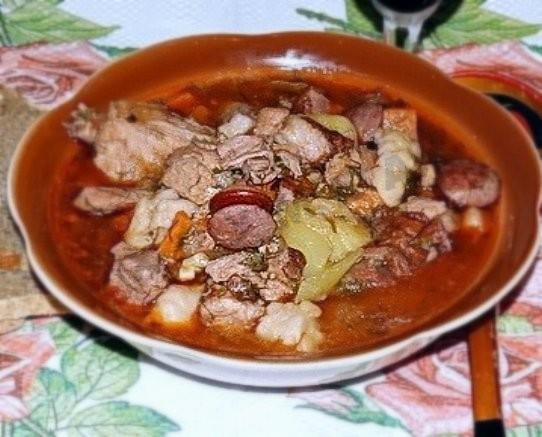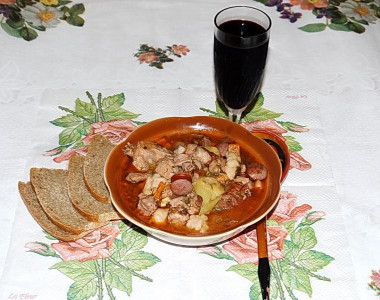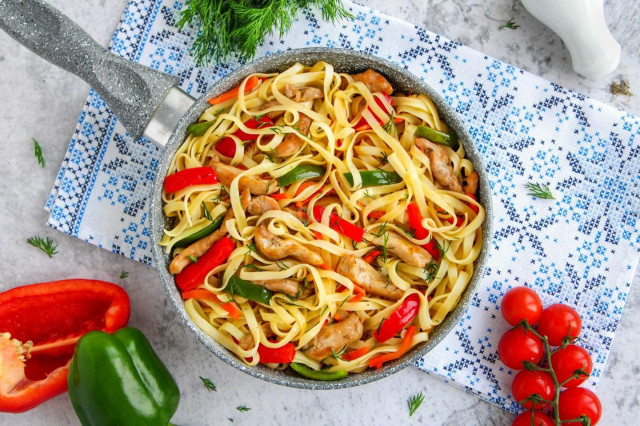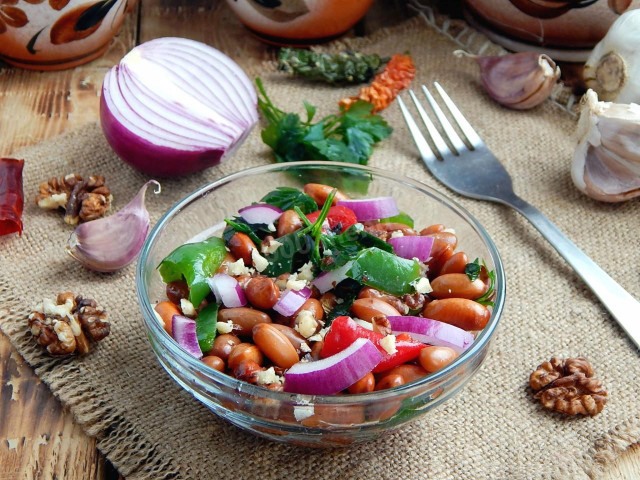Composition / ingredients
Step-by-step cooking
Step 1:
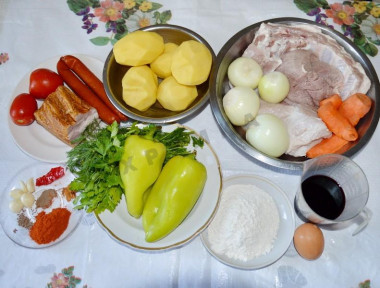
How to make bograch in Transcarpathian? Necessary products. Onions, garlic, potatoes, carrots have already been peeled, the greens have been sorted. All of the above, as well as meat and peppers, are thoroughly washed. I repeat that most of the meat and meat products are fresh, the other, smaller part is smoked products. Paprika is a must when cooking this dish, it gives it a characteristic taste.
Step 2:

Cut off the fat from the ribs and the fatter part of the podcherevka, chop it and fry until you get the flakes in a hot cauldron. Remove the pork rinds with a slotted spoon and set aside for now.
Step 3:

Cut the ribs between the bones, cut the rest of the meat into large cubes, as for pilaf.
Step 4:
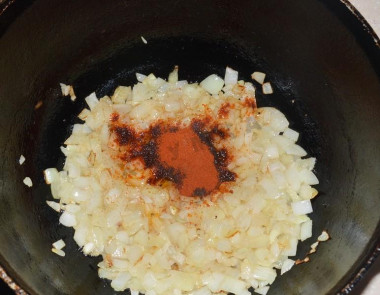
In pork fat, fry the onion pre-cut into small cubes until lightly browned, pour ground paprika into the cauldron and fry over medium heat for no more than 5 minutes, stirring. Your task is to carefully monitor the paprika: if it burns, it will hopelessly spoil the taste of such a wonderful dish as bograch.
Step 5:

After that, immediately add the diced meat and ribs, mix thoroughly and keep on fire for a couple of minutes. Add water so that almost all the meat ingredients are covered with liquid. Simmer all this over low heat, stirring occasionally.
Step 6:
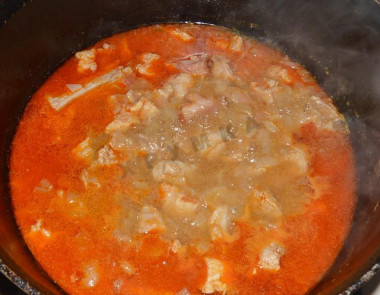
If necessary, you need to top up the water in such an amount that the meat is always in a small volume of liquid for 2-2.5 hours (until it is almost completely ready). In my bograch, the meat was young and cooked in 1 h. 50 min.
Step 7:

Now, while the meat is cooking, proceed to the preparation of "chipette" - plucked dough (Hungarian word "chipkedny" means "to pinch"). In fact, these are just small dumplings that are plucked from a piece of dough, dried a little while the goulash is being prepared, and then sent there as well. So, from 1 egg and flour, knead the dough (without water). Knead the dough well.
Step 8:

You can assemble the dough into a ball and pinch off arbitrary pieces from it, or you can roll up sausages and already pinch off shapeless pieces the size of a large nail with floured hands.
Step 9:

Then leave these pieces of dough to dry on a wooden board, lightly sprinkled with flour. Before laying in the bograch, they will need to be turned over several times on the board, evenly distributing it. When you put them in the cauldron, try to grab as little flour as possible.
Step 10:

Next, according to the recipe, add the remaining water, salt, add diced carrots, spices, hot pepper, crushed cumin and crushed garlic. Cook all this for another 30 minutes.
Step 11:
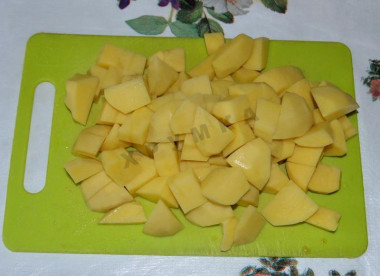
While the bograch goulash is being prepared with carrots and spices, cut the potatoes into rather large chunks.
Step 12:
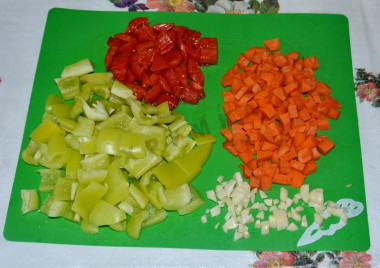
Tomatoes can be peeled, peppers must be peeled from seeds. Cut these vegetables and carrots into rather large cubes, and chop the garlic medium.
Step 13:
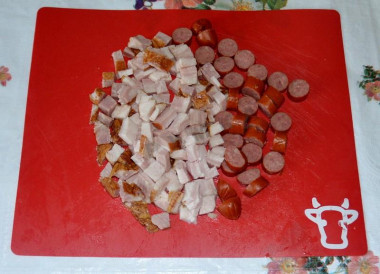
Cut sausage products into circles, and podcherevok or lard into cubes.
Step 14:
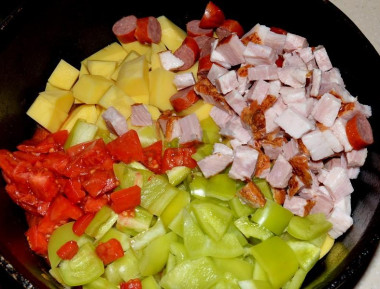
After 30 minutes, put all the chopped vegetables in the cauldron together with the previously cooked pork rinds and chopped homemade sausage (picnics) and podcherevka. Add the water again so that everything is slightly covered (by 1 finger). Cook under the lid for another 30 minutes.
Step 15:
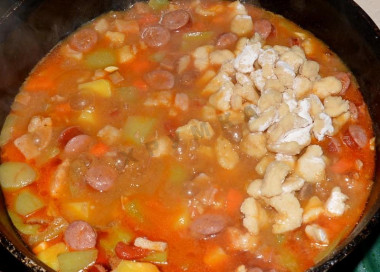
Then send it to the cauldron "chipette". They are prepared for a short time - literally 5 minutes. When they are ready, they will float to the surface of bogracha.
Step 16:

Cut a lot of greens and send them to bograch-goulash. Stir, bring to a boil and at this stage add 100 ml of dry red wine. Let it boil again and that's it - bograch-goulash is ready at home!
A little about the history of bograch:
The Hungarian word gulya means herd of cows, and gulyas means cow shepherd. Accordingly, gulyas hus (hus means meat), or gulyas for short, translates as "shepherd's meat". For many centuries, shepherds have cooked meat in their famous bogracs (pots). Hence the name of the dish bogracs gulyas – goulash cooked in a cauldron. Bograch-goulash (bograch-guiyash) can be considered a purely Transcarpathian dish, because this region has many Hungarian towns and villages, whose cooking traditions have long been assimilated with the culinary preferences of Transcarpathians.
There are a wide variety of variations of recipes for cooking this dish. In some areas, beans are put instead of potatoes, mushrooms are added somewhere.
If the dish is cooked in a pot over a fire, then put another pork or veal shank, boil it to such a state that the bones are separated, they are removed, the meat is crushed and put back into the bograch. And also, as soon as the pot leaves the fire, a burning brand of a hard-leaved or fruit tree is immersed in boiling goulash for a few seconds.
Bograch-goulash (Bogracs) is served in deep plates in large portions (400-500 g).
Bograch is actually one of the culinary business cards of Transcarpathia. In the Beregovsky district, in the village of Koson, in the first days of May, they even hold a Bogracha Festival, where several teams prepare a couple of thousand liters of food at the same time.
How to choose the perfect pot for soup, porridge or pickling cucumbers read the article about pots.
Keep in mind that the final result in this dish also depends on how you chop the carrots: grated carrots will turn into mush during heat treatment and mix evenly with the rest of the ingredients, cut into strips or cubes will retain their shape.
Since the degree of salinity, sweetness, bitterness, sharpness, acid, burning is individual for everyone, always add spices, spices and seasonings, focusing on your taste! If you put some of the seasonings for the first time, then keep in mind that there are spices that it is especially important not to shift (for example, chili pepper).
Caloric content of the products possible in the composition of the dish
- Ripe potatoes - 80 kcal/100g
- Baked potatoes - 70 kcal/100g
- Mashed potatoes - 380 kcal/100g
- Boiled potatoes - 82 kcal/100g
- Potatoes in uniform - 74 kcal/100g
- Fried potatoes - 192 kcal/100g
- Tomatoes - 23 kcal/100g
- Melted beef fat - 871 kcal/100g
- Fat beef - 171 kcal/100g
- Lean beef - 158 kcal/100g
- Beef brisket - 217 kcal/100g
- Beef - okovalok - 380 kcal/100g
- Beef - lean roast - 200 kcal/100g
- Beef shoulder - 137 kcal/100g
- Beef - ribs - 233 kcal/100g
- Beef - ham - 104 kcal/100g
- Beef - tail - 184 kcal/100g
- Boiled ham - 269 kcal/100g
- Beef corned beef - 216 kcal/100g
- Pork fat - 333 kcal/100g
- Pork meat - 357 kcal/100g
- Pork - low-fat roast - 184 kcal/100g
- Pork chop on a bone - 537 kcal/100g
- Pork - schnitzel - 352 kcal/100g
- Pork Shoulder - 593 kcal/100g
- Boar's leg - 113 kcal/100g
- Pork - 259 kcal/100g
- Sweet pepper - 27 kcal/100g
- Carrots - 33 kcal/100g
- Dried carrots - 275 kcal/100g
- Boiled carrots - 25 kcal/100g
- Pork fat - 871 kcal/100g
- Melted pork fat - 947 kcal/100g
- Pork rinds - 895 kcal/100g
- Lard - 797 kcal/100g
- Spy - 658 kcal/100g
- Garlic - 143 kcal/100g
- Parsley greens - 45 kcal/100g
- Thyme - 101 kcal/100g
- Dried thyme - 276 kcal/100g
- Thyme - 276 kcal/100g
- Dill greens - 38 kcal/100g
- Whole durum wheat flour fortified - 333 kcal/100g
- Whole durum wheat flour, universal - 364 kcal/100g
- Flour krupchatka - 348 kcal/100g
- Flour - 325 kcal/100g
- Cumin - 333 kcal/100g
- Liqueur wines - 212 kcal/100g
- Semi-dry wines - 78 kcal/100g
- Dry wines - 64 kcal/100g
- Red wine - 88 kcal/100g
- Hot capsicum - 40 kcal/100g
- Salt - 0 kcal/100g
- Raw smoked sausage - 530 kcal/100g
- Onion - 41 kcal/100g
- Ground hot pepper - 21 kcal/100g
- Paprika - 289 kcal/100g
- Chicken egg - 80 kcal/100g
- Pork ribs - 321 kcal/100g

